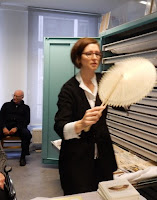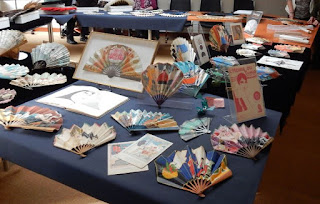Freitag Vormittag öffnete das Spitzen- und Modemuseum seine derzeitige Ausstellung über die Krinoline und sein Archiv, um uns seine Fächerschätze zu zeigen:
The weekend of 23-25 October was the fan weekend: 30 fan collectors, not only from Germany, but also from Italy, the UK, Belgium and the Netherlands participated in the Annual meeting of German fan collectors in Brussels. The programme was divers and intense: Friday morning started with the Lace and Fashion Museum that opened its current exhibition on the Crinoline and its archives to us:
Caroline Esgain, Director or the museum, with a wonderful Chinese Cockade fan
"Krinoline & Co - Ausgestellte Bürgerlichkeit" (bis 10.4.2016)
"Crinoline & Cie - the Bourgeoisie on display" (until 10 April 2016)
Freitag nachmittags ging es zum "Cinquentenaire", wo das Königliche Museum für Kunst und Geschichte seine Türen öffnete. Sophie Balace, Kuratorin für Preziosa, stellte uns 5 Fächer aus der Sammlung vor, darunter der mittlerweile berühmte "Surprise-Faltfächer" aus dem späten 17. Jahrhundert: "Crinoline & Cie - the Bourgeoisie on display" (until 10 April 2016)
Friday afternoon found us at the Royal Museum of Art and History in the Cinquentenaire park where Sophie Balace, curator for preziosa, showed us 5 special fans from the archive, amongst them the rare Surprise folding fan from the late 17th century:
Surprise-Faltfächer mit erstaunlich frischen Farben
Surprise folding fan, late 17th c., with astonishingly fresh colours
Surprise folding fan, late 17th c., with astonishingly fresh colours
Fächer der brabantischen Revolution (zeitgleich und im Stil ganz wie die französischen Revolutionsfächer)
Fan of the Brabant revolution (same time and same style as the French revolutionary fans)
Samstag Vormittag war drei Vorträgen gewidmet: Hans Merkle über die Fächermaler Karl und Georg Gimbel, Vera Kistner stellte ihren "scheinbar unscheinbaren" Fächer vor, ein Souvenir eines Theaterabends auf dem Schloss von Mouchy 1863. Und Margaetha Mazura leitete mit "Der Weg zu Art Deco" zur nachmittäglichen Ausstellung ihrer Jugendstil und Art Deco Fächer, sowie jener der Sammlung HS aus Belgien, über. Ein Video über die Fächerausstellung U.G. Hoffmanns schloss den Vormittag ab.
Saturday morning saw 3 presentations: Hans Merkle's research on the fan painters Karl and Georg Gimbel; Vera Kistner presented her "conspicuously inconspicuous" fan, a souvenir of a theatre performance at the Chateau de Mouchy in 1863. And Margaretha Mazura showed the Path towards Art Deco, which led to the afternoon exposition of her Art Nouveau and Art Deco fans and those of the Belgian HS collection. A video about the fan exhibition of U.G. Hoffmann ended the morning.
Saturday morning saw 3 presentations: Hans Merkle's research on the fan painters Karl and Georg Gimbel; Vera Kistner presented her "conspicuously inconspicuous" fan, a souvenir of a theatre performance at the Chateau de Mouchy in 1863. And Margaretha Mazura showed the Path towards Art Deco, which led to the afternoon exposition of her Art Nouveau and Art Deco fans and those of the Belgian HS collection. A video about the fan exhibition of U.G. Hoffmann ended the morning.
Pfauenfächer gemalt von Thomasse, von Eva
Thomasse' peacock fan of Eva
Gendrot-Fächer von Rose
Gendrot fan of Rose
Die deutschsprachige Gemeinschaft Belgiens stellte für die Ausstellung am Samstag Nachmittag die Räumlichkeiten zur Verfügung.
The afternoon exhibition was hosted by the German-speaking Community of Belgium in Brussels.
Jugendstil und Art Deco Fächer von mm
Art Nouveau and Art Deco fans of mm
Federfächer der HS Sammlung, Brüssel
Feather fans of the HS collection, Brussels
Ich hätte gerne auch das gemütliche Abendessen gezeigt, aber leider sind viele Sammler kamerascheu...
I would have liked to add some faces to the fans, in particular of the convivial dinner, but many fan collectors are camera-shy...




















